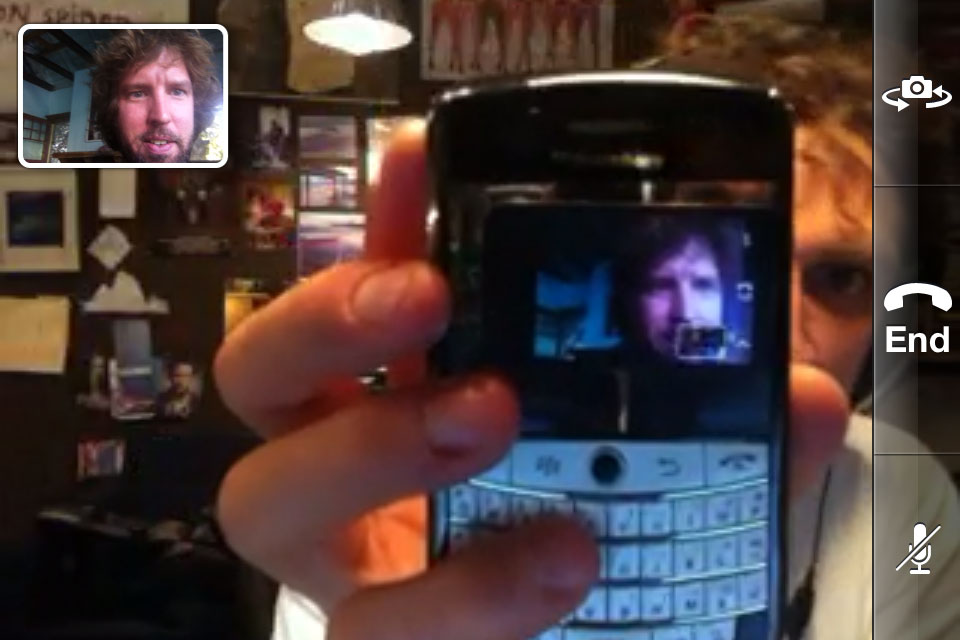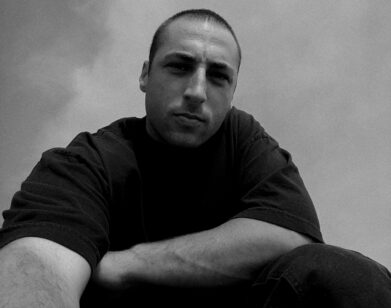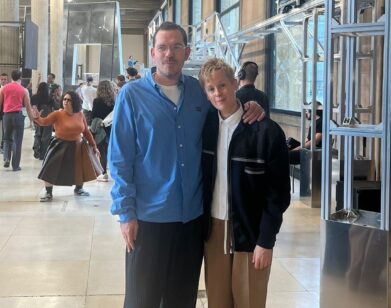Marc Horowitz
Marc Horowitz’s life—a series of comic jokes and manic adventures that invite, even provoke audience participation—bleeds into his art. So it makes a lot of sense that The Advice of Strangers, presented with Creative Time and for which the artist put his own life choices up for vote online, officially concluded November 30, but will continue into the future and Art Basel Miami Beach, where Horowitz’s online audience can vote on what he should present. His friend and collaborator, filmmaker Casey Neistat, troves the artist’s eccentric history. The artists spoke all week, and captured their conversations in original iPhone photos.
CASEY NEISTAT: I did some Internet research on you, even though I’ve gotten to know you over the last year, doing our video phone project. This would’ve been a really interesting conversation had I not contaminated it by trying to understand your history better… But something I didn’t know about you, which I read on Wikipedia… Did you do your own Wikipedia page?
HOROWITZ: Don’t tell anyone.
NEISTAT: Well, it says you left home when you were 15. I too left home when I was 15. My mom left her parents’ house when she was 15, too, which I think is a magical age to be on your own. But as I get older it seems like a crazy thing to have done.
HOROWITZ: What old are you now, 32? 34?
NEISTAT: I’m 29. Take it easy.
HOROWITZ: I’m not trying to age you. I’m 34. You’re nowhere near adulthood, you poor little thing. But leaving home, I had no idea what I was getting into. It was gnarly. My mom took off for a month, and left me in a house all alone. I had my first party; I got drunk for the first time; I drove a car for the first time. I busted open my chin, I went to go to the hospital to get stitches and they were like, “Yeah, you need a parent’s signature,” so I put duct tape on it. I lost my virginity. Then she came back in this brand-new car and she was like, “I’d like you to meet your new stepfather.” I was like, “What the fuck? What am I, in some movie?”
NEISTAT: How long did this last?
HOROWITZ: This was a month. My mom saw a psychic who said she’d meet her future husband on the steps of the Evansville Public Library, so she went there. She found this guy and they went to the Poconos and they left me in the house and I got everything out of my system. Then the guy moved to Sacramento, California, which for me was culture shock. I had never seen a manicured lawn, systematic sprinklers for example. [LAUGHS] My mom got a job in Blythe, California, to teach and she was like, “You can come with me to the middle of the desert or you can stay with your stepfather.” So I went back to live with my friend in Indiana in his basement. With my learning permit, I drove over the mountains to Indiana and I started living in this tiny town of like 300 called Chalmers, Indiana, a town with one stoplight, a cop named Cletus, and one grocery store called Mark’s Foods, and I lived there for a year. I went to high school and got in a shit ton of trouble because I had a fake I.D., so as a job I would buy students beer and liquor and that’s how I made my money. My other friend sold acid and so we were making it happen, man. And then he got jealous because I was getting in so much trouble and he kicked me out.
I’m going into my senior year at this point… I contacted the church and said I was a foreign exchange student, of sorts. [LAUGHS] They paired me up with this old lady who was senile. She would sit on the edge of my bed in the morning and stroke my leg. She had a senile dog that would shit on the floor, and she would accuse me of shitting on the floor, and she would go ape-shit on me. She would be drunk on gin: “What the fuck is the meaning of this, you shitting on my floor?” And I’m just like, “Dude, it’s your dog. Swear to god.”
It was a weird relationship so I left there, moved in with another family, and that was a militant situation. Then I started melting down and working on the cornfields for four bucks an hour. I finished high school, and a friend was going to business school at Indiana University. He said there were lots of girls there. During the interview I leaned back in this big chair and hit the bookshelf and knocked over an ancient Peruvian statue. But I got in.
NEISTAT: How did that beginning, breaking a statue, lead you to a fancy education… you got a Master’s from San Francisco Art Institute?
HOROWITZ: I don’t have a Master’s from there, although a lot of people think I do. It went like this: I went to business school and got focused midway through my sophomore year. Then I met some art students and took my first art class ever, a painting class with this guy Richard Barnes. I loved it. I went into the school to convince the person who hands out studio keys to give me one, and I started studying and going to critiques. I had stolen a bunch of money from a source that I didn’t feel too bad about [taking it from], so I took a trip to Europe with that money and taught myself art history, essentially.
NEISTAT: Then around that time you got a job in Silicon Valley, right?
HOROWITZ: I came back and got a job in Silicon Valley as a project manager. They didn’t hire me; they told me I was unqualified. So I went in the back and made friends with everybody. I showed up every morning when they showed up, and eventually they brought me on at a very low salary. Then they also started covering classes, which they thought were graphic design classes, but which were painting classes that I was taking with a special-forces Vietnam sergeant named Skip. I studied with him for two years. He got me a scholarship to the San Francisco Art Institute and so I left the dot-com group, which crashed a year later.
At that time I would squat in the cookie factory with these dudes from Stanford who were studying artificial intelligence, and this mathematician from Berkeley, and a fashion designer. I went there as a painter, and it blew my mind when I met this guy Harrell Fletcher and Jon Rubin, and they were working at an incipient form of relational art and performance. For my first project I went down on Market and Howl Street in San Francisco and handed out blank sheets of paper and said, “Free Ideas!” It was unbelievable.
NEISTAT: What was the response? That these were sort of alchemical pieces of paper?
HOROWITZ: People couldn’t thank me enough. Homeless people wanted me to write letters to their parents; kids wanted to have paper airplane-throwing contests. Tourists thought I was a fucking freak, so they wanted a picture with me, and a Jesus freak told me I was doing God’s work. It was insane: I was introducing one element, a blank sheet of paper, to an audience. I introduced these pretty banal elements into the work. I said, “How about a burrito at my favorite place?” And I’d share a burrito with somebody.
NEISTAT: I want to jump in there because I think that handing out the sheet of paper is crucial. What differentiates your work is that you’re not afraid to move impulsively, or use really elemental tropes. It’s about accessibility but it’s also about pushing ideas. “Basic” is a good word; the works have an irreverence and comedy, a willful stuntedness. You’re age 13 and then that’s it.
HOROWITZ: I actually just enrolled in a masters program at USC to get my Master’s of Fine Arts and finding it really hard because of exactly what you’re talking about. I’m not really an intellectual, you know? I think I’ve made a lot of my process like taking ideas that are small; some would say that they’re half-baked. What would it look like to sign your name on a map of the U.S. and then drive that? What would it look like to bring a mule around San Francisco and do your errands on a mule? Once you start something, everything else opens up and you have to trust life.
NEISTAT: I think that’s an extraordinary, poignant thing. For me, when we came out with a TV show, my HBO show, so much of the feedback was, “How do I do it?” And my response was always the same: “Just make something.” Stop talking about it. You do in a way that the work takes on a life of its own. Like the “Signature” series [(2008), in which the artist trekked across the United States in the shape of his own signature] was a simple concept that became this story about the people you met along the way.
HOROWITZ: Most of my work involves engaging strangers with an absurd principle. I agree with you—ideas are cheap, dude, unless you act on them. Many of my projects suck, but I’m a maximalist. The Advice of Strangers developed because I exhausted my friends with my questions, and then, what would it be like to open up this art-making process, this profit-making process, this axis at the core of what an artist or an entertainer or a producer of culture does? Decisions are the core of work.
NEISTAT: Do you ever consider taking your personality out of the work?
HOROWITZ: Definitely, but I’m conscious of the fact that I am the center of this universe I’ve created. It’s exhausting. I don’t want to make paintings or sculpture, so I’m left with performance and video, and I don’t know if I trust anybody else’s way to do this.
NEISTAT: Right, a struggle for me, doing the HBO show, is using the right tools, which for you is performance and for me is very specifically filmmaking. I think an interesting comparison in the course of your career is the G4 show, “It’s Effin’ Science” (2010-) and The Advice of Strangers. I would say The Advice of Strangers is 90% Marc and 10% concept, and “It’s Effin’ Science” is 90% the concept of a science show, and 10% Marc.
HOROWITZ: The thing is with “It’s Effin’ Science,” it was a job. As an artist, you’ve got to support yourself, and I played the role of the guinea pig. But yeah, I’m on this fence looking at the entertainment world and on the other side, the art world. They cut like 95% of what I did, because they just thought it was too borderline for their audience, and so making a project like The Advice of Strangers was generous, and enabled me.
NEISTAT: Tell me about The Advice of Strangers—in two sentences, go.
HOROWITZ: I want to connect people via tiny, absurd historical moments that we create and share. It’s a collaboration with an anonymous community.
NEISTAT: My favorite video was definitely, “Is this project working?” Which is one of the earlier ones, and there was a whole lot less fanfare. It was just you sitting on a couch trying to figure out if your project was working. That raised big questions for me, because you thought a lot about audience: “Is this too broad?” “Is this too narrow?” “Should we be compartmentalizing this to make it easier to follow?” “Should we be opening this up more?” What are the successes and failures of the project thus far?
HOROWITZ: It’s shifted from what I imagined. I thought about giving up agency and control, and about looking at how social networks affect our lives. Then the project became not about that. I couldn’t offer up all my daily decisions. So it’s about asking the right questions, and I’m realizing how much control we actually have in our lives. When I first started I thought, “We don’t have any control in our lives; everything just sort of happens,” but now I think, no, we have complete control and we know what we want to do and we have a good idea of where we want to go: It’s just about asking the right questions. It wasn’t about proof, or whether the advice of strangers is better than my intuition. It became an inquiry into how advice functions. Where is it taking you? How is it pushing you? Like when I went on that Echo Park Lake on an air mattress… I’m terrified of water. I just did it.
NEISTAT: Is this entertainment? Is this art? Not that the work necessarily needs a label, but certainly in your approach, there is some consideration.
HOROWITZ: I think it can be both. I’m naturally inclined to want to be funny and make people laugh, and that’s what I want to do with my life. I also want to do it on an intelligent level. I want to kill the clown but I also want to preserve the comedian. I want the site to function as entertainment, and the videos are cut and presented to reflect that. Then there are moments that are real, that are pathos, where I break down where I’m questioning whether this is art or entertainment; if I’m a cultural producer or a cultural critic, and when does performance stop and real life begin?
NEISTAT: If this were a five-month project instead of a one-month project, what do you think it would metamorphosis into?
HOROWITZ: I guess if it went over a period that long, I would have to change the processes of having a shooter and editor help me. That was just so that I could get these things out quickly as opposed to doing a live stream, which is so boring and laborious. I would probably just start shooting on my own and it would get more and more banal, I’m certain. I think eventually these strangers would become my friends, because of the nature of the comments and the way this thing is set up, where there are announcements and people can comment and I look at their comments and take them into consideration and pull. I would end up asking larger questions, too, like should I continue with school, or should I quit? You know, should I take this job with such and such?
NEISTAT: Would you be willing, for the sake of art or for the sake of your career, really allow your life to be dictated in a way that is actually more significant than which bar should you go to on a given night?
HOROWITZ: Sure, yeah, of course. It’s happened. I’ve been taping therapy sessions, and I had to take one of them down, because it was about my mom, and it really affected our relationship, and now we’re going to be going to counseling together as a result. I did a project called Talk Show 247 where I lived my life online for three months straight, 24 hours a day, 7 day a week, always on camera, and it made me crazy. There is no more private really, and everything you do is public, and it’s hard because there are certain things that are off-limits. My mom is now off-limits. My girlfriend is off-limits. So you begin to shut off areas of your life. Josh Harris participated in [Ondi Timoner’s] documentary made about him, We Live in Public. He was an Internet mogul and decided to live his life 24/7 on camera for a year. He went through a divorce, he gained a lot of weight, his company sank and he was near suicide. Then he quit and bought an apple farm and freaked out and moved to India. I just don’t ever think that these self-imposed surveillance projects in the long term really ever end up being that positive.
NEISTAT: So why do you do a project like this?
HOROWITZ: Why do a project like this? I feel like it’s a natural extension of the work that I’ve been doing, which is working with the public and working with strangers. I felt like inviting them directly into the decision making process of a work and then making that work with them, made sense to me. But, you know, I don’t know if it was the best decision.







